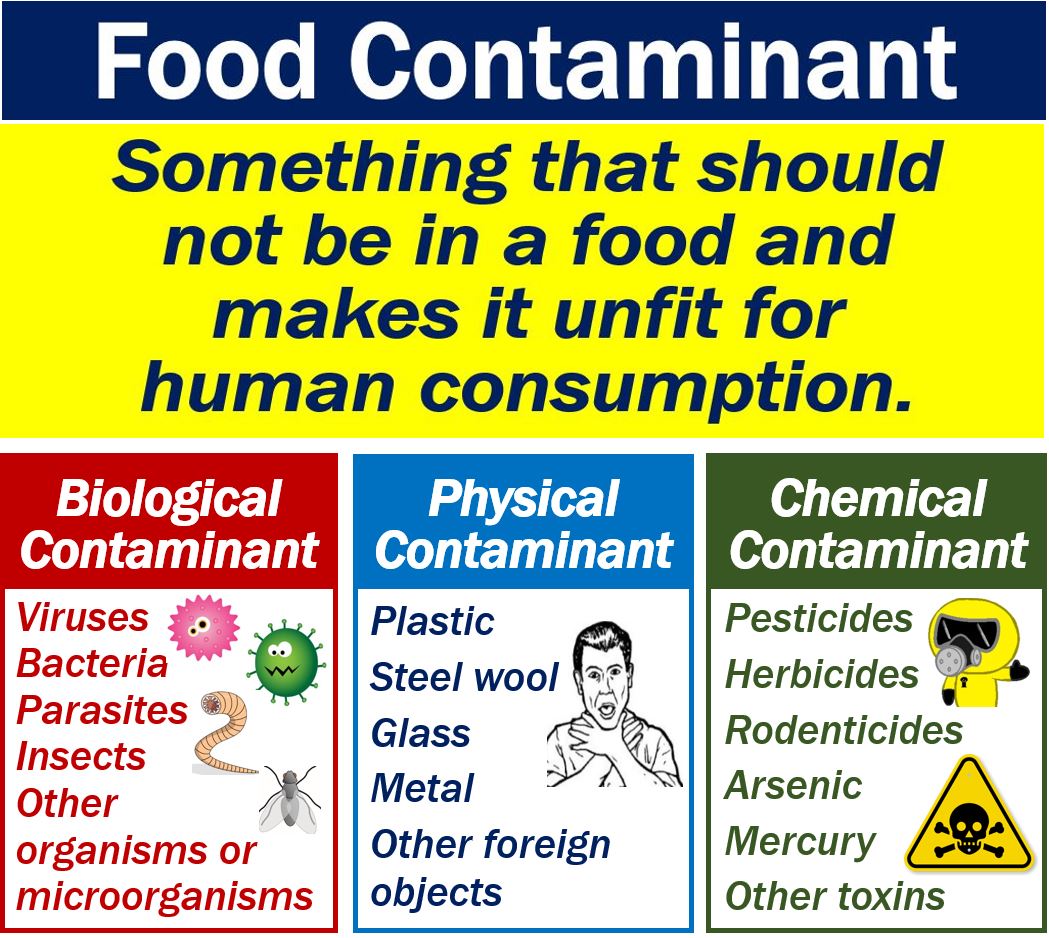What is a food contaminant? Definition and examples
A Food Contaminant is a substance, object, or organism that makes food unfit for human consumption.
The contamination of the food may have occurred by accident or on purpose. Some dictionaries and authorities say that the term only includes substances that got into food by mistake. A food contaminant may also be something that somebody added to a foodstuff to make it bulkier or weigh more. Somebody may have added water to milk, for example, to increase its volume.
A food contaminant might be harmless food that is not in the right place. Carrots, for example, might be in a bag of frozen broccoli.
Cross-contamination during food preparation can also introduce contaminants from safe foods to others, increasing the risk of food-borne illnesses.
Examples
Examples of substances or organisms that can make food unfit for human consumption are insects, pests, dust, or biocides. Animal feces and pathogenic microorganisms may also make food unfit to eat. Pathogenic means it can cause disease.
The Hong Kong Government’s Centre of Food Safety says the following regarding the term:
“Food contaminants are any harmful substances unintentionally added to food, which may be chemicals from natural sources, environmental pollution, or formed during food processing.”

Food contaminant types
There are three types of food contaminant: 1. Biological. 2. Physical. 3. Chemical.
-
Biological
A biological food contaminant is either an organism or a substance that an organism produces. This includes biological matter that microorganisms, insects, rodents, and humans produce.
The two main causes of biological contamination are viruses and bacteria. They can cause some of the most common foodborne illnesses.
A foodborne illness is an illness that exists because of something we ate. If I eat chicken contaminated with salmonella and subsequently become ill, I have a foodborne illness.
Regarding protecting yourself from bacterial contamination, the Australian Institute of Food Safety writes:
“Thoroughly washing your hands and sanitising (US: sanitizing) the food handling equipment are two of the best ways to prevent against bacterial contamination.”
-
Physical
A physical contaminant is a foreign object in food, i.e., it should not be there. Physical contamination may occur at any stage of the production process.
Pieces of plastic, glass, and steel wool, for example, may contaminate food.
The main risk for people who eat foods with physical contaminants in them is injury. However, some injuries or undesirable events are life-threatening. For example, if a piece of plastic gets stuck in your throat, you might not be able to breathe.
If a physical contaminant is carrying a biological contaminant, there is a risk of disease or infection.
-
Chemical
Chemical contaminants are either artificial or natural substances that got into food. In some cases, the chemical is toxic, i.e., poisonous. Toxins can make us ill and even kill us.
The impact of a food contaminant on consumer well-being and health is often not apparent for many years. It can take decades before we become aware that anything is wrong.
Unlike biological contaminants, thermal processing does not affect many chemical contaminants. Thermal processing is a commercial technique to sterilize food by heating it.
Implementing rigorous quality control checks throughout the supply chain can significantly reduce the incidence of food contamination.
Below are some examples of chemical food contaminants:
Agrochemicals
Agrochemicals are chemicals that farmers use, such as herbicides, insecticides, and rodenticides. Plant growth regulators and veterinary drugs are also examples of chemicals that farmers use.
Environmental contaminants
Environmental contaminants include chemicals that are present in the environment where we grow food. They may also exist in the environment where we process, package, store, transport, and consume food.
The food may become contaminated when it comes into contact with its environment. Arsenic and mercury, for example, are environmental contaminants that exist in water.
Radionuclides, such as cesium-137 and polycyclic aromatic hydrocarbons are present in the atmosphere.
Perchlorates, cadmium, and nitrates are contaminants that exist in the soil. Bisphenol A and sanitizing agents exist in packaging materials and processing/cooking equipment respectively.
Regarding hair in food, Wikipedia says the following:
“There is a heavy stigma attached to the presence of hair in food in most societies.”
“There is a risk that it may induce choking and vomiting, and also that it may be contaminated by toxic substances. Views differ as to the level of risk it poses to the inadvertent consumer.”
Example sentences
Below are some example sentences containing the term “food contaminant,” to help you see how we can use the term in context.
- “After the recall was announced, the food safety inspector determined that the food contaminant was a batch of spoiled cream used in the ice cream production.”
- “During the cooking class, the chef emphasized the importance of proper food handling to avoid the introduction of a food contaminant that could spoil the dish.”
- “The laboratory tests confirmed that the cause of the illness was a food contaminant, specifically a pesticide residue that exceeded safe levels.”
- “The food processing company implemented advanced detection equipment to identify any potential food contaminant before products reached the consumer market.”
- “The restaurant faced severe penalties after health inspectors found a food contaminant in the form of rodent droppings in the storage area.”
- “Consumers were warned to wash their produce thoroughly to remove any potential food contaminant that might have come from contaminated soil or water.”
- “In the latest industry workshop, the main topic of discussion was innovative strategies for food contaminant prevention in packaged goods.”
Video – What is a Food Contaminant?
This video presentation, from our YouTube partner channel – Marketing Business Network, explains what ‘Food Contaminant’ means using simple and easy-to-understand language and examples.

